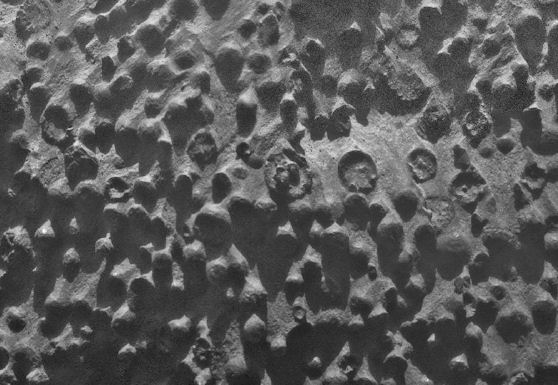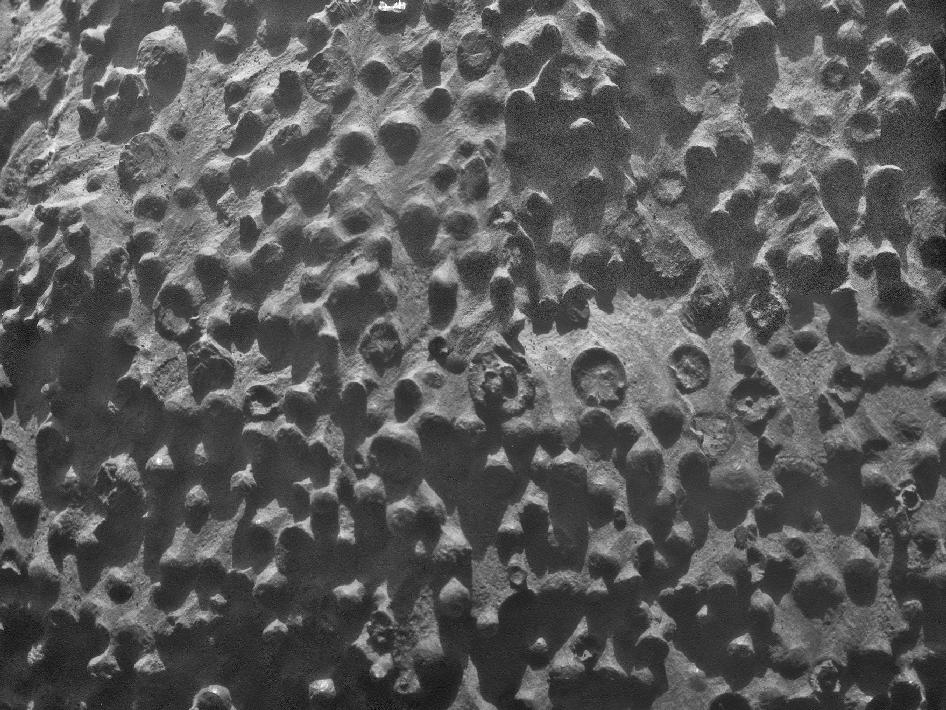Newly photographed Martian spheres pose mystery for scientists

In July 1965, Mariner 4 – NASA’s first spacecraft to fly by Mars – sent back its first images to Earth. Since then, dozens of spacecraft have been sent to explore the cold red planet. Consistently, the planet has raised far more questions than answers. In 1996, Sojourner was the first mobile rover to land on Mars. Additionally, the Mars Pathfinder mission was a huge success. It has sent a massive amount of data and images. Opportunity, which landed in 2004, is currently sending some interesting photographs back to mission control in Pasadena California. All of these different explorations of Mars have presented startling opportunities.
As of the last week planet offered us a bubbly question about an outcrop dubbed “Kirwood” on the western rim of the Endeavour Crater. Opportunity sent back images of spherical objects up to 3 mm in diameter. Initially they seemed to resemble the “blueberries” photographed by Opportunity near its landing site in 2004.
Upon further observation, it has been determined that they differ in almost all ways from the original blueberries. The original blueberries of 2004 were formed by deposits of hematite through water saturating the bedrock. The new patch of spheres discovered last week in Kirkwood are not iron-rich, and differ in spacing and general composition from the initial find. Image below was recorded on September 6, 2012.

At this point only speculation and questions exist about the cause of this unusual and exciting find. Interestingly, the spheres were described as having “soft” interiors by NASA. NASA also recently published an article suggesting that water may be flowing during the warmest months on Mars based on photographs from the Mars Reconnaissance Orbiter. Whether these two discoveries are related is yet to be determined. As all of this new information comes to light, questions mount and beg for answers in the years to come.
Just past Kirkwood lies another science target area for Opportunity. The location is an extensive pale-toned outcrop in an area of Cape York where observations from orbit have detected signs of clay minerals. That may be the rover’s next study site after Kirkwood. The rover’s energy levels are favorable for the investigations. Spring equinox comes this month to Mars’ southern hemisphere, so the amount of sunshine for solar power will continue increasing for months.
“The rover is in very good health considering its 8-1/2 years of hard work on the surface of Mars,” said Mars Exploration Rover Project Manager John Callas of NASA’s Jet Propulsion Laboratory in Pasadena, Calif. “Energy production levels are comparable to what they were a full Martian year ago, and we are looking forward to productive spring and summer seasons of exploration.”
Sources: nasa.gov…, nasa.gov/mission_pages
Featured image: Small spherical objects fill the field in this mosaic combining four images from the Microscopic Imager on NASA’s Mars Exploration Rover Opportunity. For a color view of the Kirkwood outcrop as Opportunity was approaching it two weeks earlier, see PIA16128. Opportunity discovered spherules at its landing site more than eight-and-a-half years earlier. Those spherules were nicknamed “blueberries.” They provided important evidence about long-ago wet environmental conditions on Mars because researchers using Opportunity’s science instruments identified them as concretions rich in the mineral hematite deposited by water saturating the bedrock. A picture of the “blueberries” from the same Microscopic Imager is PIA05564. The spherules at Kirkwood do not have the iron-rich composition of the blueberries. They also differ in concentration, distribution and structure. Some of the spherules in this image have been partially eroded away, revealing concentric internal structure. Opportunity’s science team plans to use the rover for further investigation of these spherules to determine what evidence they can provide about ancient Martian environmental conditions. Credit: NASA/JPL-Caltech/Cornell Univ./ USGS/Modesto Junior College

Some kind of worm casts perhaps? It looks soft and wet enough.
I should have course said Pingos collapsing into thermokarst features.
All the science aside, which has been incredible, I find it beyond belief that little Opportunity is still functioning and doing credible scientific data collection. My hat is off to all the engineers and software specialists that have given this small rover a tenacity and perseverance beyond any expectation. Congratulations on spending our tax dollars in such an awesome and peaceful way.
If the reports of ‘snow’ on mars are correct it would lead one to suspect that a thermokarst topography is not too much of a stretch of the imagination. Indeed, in the photographs attached to the article some typical karst collapses are evident.